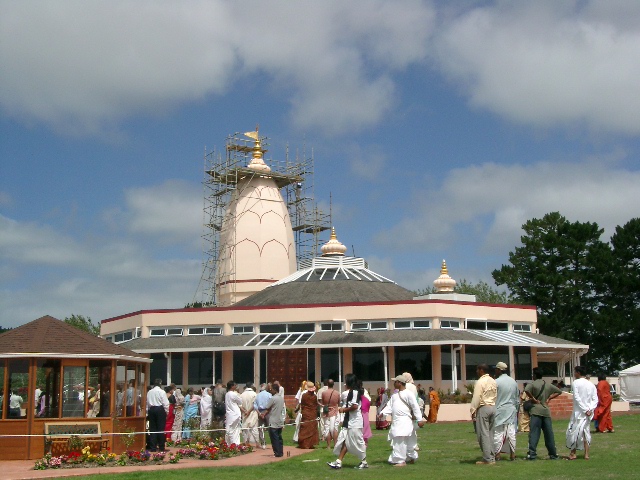
Sri Sri Radha-Giridhari Mandir

New Varshan - Hare Krishna Community, Next to the Huapai
Golf Course,
1229 Coatesville-Riverhead Highway 28., R.D. 2, Kumeu,
Auckland.
Founder Acharya Srila A.C. Bhaktivedanta
Swami Prabhupada.
last updated 24th July 2006
 New
temple (now open pictured above)
New
temple (now open pictured above)
Grand Opening 16th,17th,18th
January 2004
See
the pictures
updated 2nd March 2004

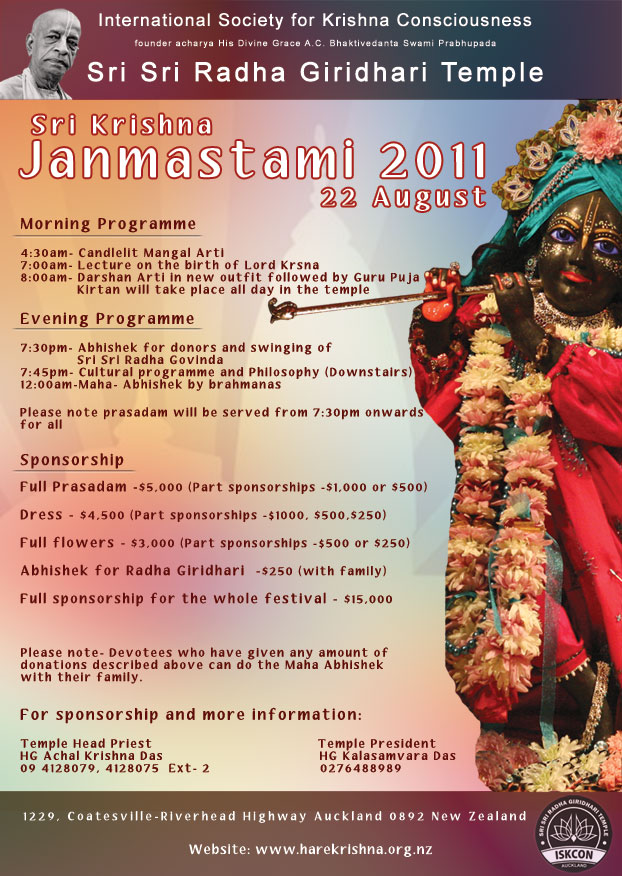
 Sri
Sri Radha Giridhari Daily Temple Program:
Sri
Sri Radha Giridhari Daily Temple Program:
 Deity
Darshan
Deity
Darshan
 Coming
festivals and events: (Janmastami, Kartik, Nama hatta 108 programs,
Gita Jayanti etc)
Coming
festivals and events: (Janmastami, Kartik, Nama hatta 108 programs,
Gita Jayanti etc)
 Dedication
to our Founder Acharya Srila A.C. Bhaktivedanta Swami Prabhupada
Dedication
to our Founder Acharya Srila A.C. Bhaktivedanta Swami Prabhupada
 What
is Hare Krishna - Iskcon?
What
is Hare Krishna - Iskcon?
 Auckland
Nama Hatta:
Auckland
Nama Hatta:
 The
Sunday Love Feast:
The
Sunday Love Feast:
 Matchless
Gifts - Temple Shop:
Matchless
Gifts - Temple Shop:
 Temple
Book Table:
Temple
Book Table:
 Food
For Life - KRd:
Food
For Life - KRd:
 Hare
Krishna School: State Integrated "Special Character" Primary School
Hare
Krishna School: State Integrated "Special Character" Primary School
 Youth
Pages - Summer Camp - Gurukula
Youth
Pages - Summer Camp - Gurukula
 Kiwi
Youth pages:
Kiwi
Youth pages:
 Ideas
for helping at the New Temple:
Ideas
for helping at the New Temple:
 Marriage
Compatibility Astrology
Marriage
Compatibility Astrology
 Marriage
Ceremonies
Marriage
Ceremonies
 Article
describing the temple opening rituals and their significance
Article
describing the temple opening rituals and their significance
 An
overview of the temple opening 2004
An
overview of the temple opening 2004
 Back
to Godhead Article on Auckland Temple by Janananda prabhu ACBSP - Back
to Godhead - March/April 2005
Back
to Godhead Article on Auckland Temple by Janananda prabhu ACBSP - Back
to Godhead - March/April 2005
 Newsletters:
Newsletters:
 The
Conch Newsletter - newsletter of the Sri Sri Radha Giridhari
temple community
The
Conch Newsletter - newsletter of the Sri Sri Radha Giridhari
temple community
 Vegetarianism
& Beyond - Interesting articles - information - history
- arguments - links............
Vegetarianism
& Beyond - Interesting articles - information - history
- arguments - links............
...in fact verything you want to know about Vegetarianism and Beyond:
 New
Zealand Directory - "Kiwi yatra" page:
New
Zealand Directory - "Kiwi yatra" page:
 The
Official Auckland Temple web-site:
The
Official Auckland Temple web-site:
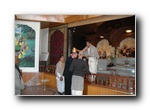 Rt
Hon. Chris Carter's Visit to Iskcon Temple 24th July 2006
Rt
Hon. Chris Carter's Visit to Iskcon Temple 24th July 2006
RT. HON. CHRIS CARTER, MINISTER
FOR ETHNIC AFFAIRS, UNVEILS “1 MILLION DOLLAR” PAINTING AT AUCKLAND HARE
KRISHNA TEMPLE
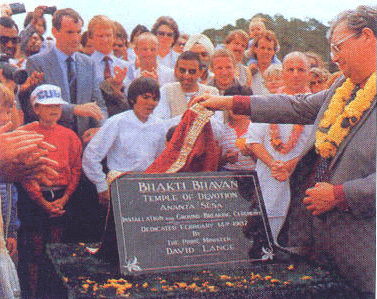 Condolences
to family and friends of late former Prime Minister the Rt hon David Lange
Condolences
to family and friends of late former Prime Minister the Rt hon David Lange
Tribute to David Lange from
Madri devi dasi
Update for Festivals at the Auckland
temple


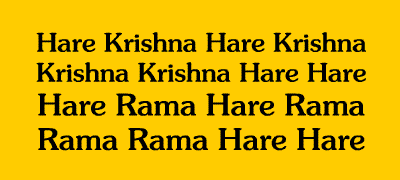

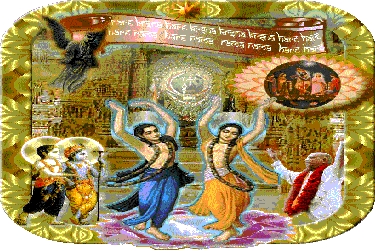
Our Dedication to our Founder Acharya Srila A.C. Bhaktivedanta Swami
Prabhupada
His Divine Grace A. C. Bhaktivedanta Swami Prabhupada appeared in this
world in 1896 in Calcutta, India. He first met his spiritual master, Srila
Bhaktisiddhanta Sarasvati Gosvami, in Calcutta in 1922. Bhaktisiddhanta
Sarasvati, a prominent religious scholar and the founder of sixty-four
Gaudiya Mathas (Vedic institutes) in India, liked this educated young man
and convinced him to dedicate his life to teaching Vedic knowledge. Srila
Prabhupada became his student and, in 1933, his formally initiated disciple.
At their first meeting Srila Bhaktisiddhanta Sarasvati requested Srila
Prabhupada to broadcast Vedic knowledge in English. In the years that followed,
Srila Prabhupada wrote a commentary on the Bhagavad-gita, assisted the
Gaudiya Matha in its work, and, in 1944, started Back to Godhead, an English
fortnightly magazine. Single-handedly, Srila Prabhupada edited it, typed
the manuscripts, checked the galley proofs, and even distributed the individual
copies. The magazine is now being continued by his disciples in the West.
In 1950 Srila Prabhupada retired from married life, adopting the vanaprastha
(retired) order to devote more time to his studies and writing. He traveled
to the holy city of Vrndavana, where he lived in humble circumstances in
the historic temple of Radha- Damodara. There he engaged for several years
in deep study and writing. He accepted the renounced order of life (sanyasa)
in 1959. At Radha-Damodara, Srila Prabhupada began work on his life's masterpiece:
a multivolume commentated translation of the eighteen-thousand-verse Srimad-Bhagavatam
(Bhagavata Purana). He also wrote Easy Journey to Other Planets.
After publishing three volumes of the Bhagavatam, Srila Prabhupada came
to the United States, in September 1965, to fulfill the mission of his
spiritual master. Subsequently, His Divine Grace wrote more than fifty
volumes of authoritative commentated translations and summary studies of
the philosophical and religious classics of India.
When he first arrived by freighter in New York City, Srila Prabhupada
was practically penniless. Only after almost a year of great difficulty
did he establish the International Society for Krishna Consciousness, in
July of 1966. Before he passed away on November 14, 1977, he had guided
the Society and seen it grow to a worldwide confederation of more than
one hundred asramas, schools, temples, institutes, and farm communities.
In 1972 His Divine Grace introduced the Vedic system of primary and
secondary education in the West by founding the gurukula school in Dallas,
Texas. Since then his disciples have established similar schools throughout
the United States and the rest of the world.
Srila Prabhupada also inspired the construction of several large international
cultural centers in India. The center at Sridhama Mayapur is the site for
a planned spiritual city, an ambitious project for which construction will
extend over many years to come. In Vrndavana are the magnificent Krsna-Balarama
Temple and International Guesthouse, gurukula school, and Srila Prabhupada
Memorial and Museum. There is also a major cultural and educational center
in Bombay. Major centers are planned in Delhi and in a dozen other important
locations on the Indian subcontinent.
Srila Prabhupada's most significant contribution, however, is his books.
Highly respected by scholars for their authority, depth, and clarity, they
are used as textbooks in numerous college courses. His writings have been
translated into over fifty languages. The Bhaktivedanta Book Trust, established
in 1972 to publish the works of His Divine Grace, has thus become the world's
largest publisher of books in the field of Indian religion and philosophy.
In just twelve years, despite his advanced age, Srila Prabhupada circled
the globe fourteen times on lecture tours that took him to six continents.
Yet this vigorous schedule did not slow his prolific literary output. His
writings constitute a veritable library of Vedic philosophy, religion,
literature, and culture.

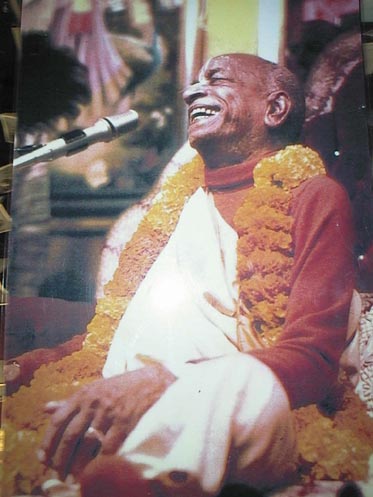
Visit "Prabhupada Connect" for all manner of Prabhupad
Nectar:
http://www.prabhupadaconnect.com/Index.html

Download or Listen to Prabhupad Bhajans HERE:
http://www.prabhupadavani.org/web/text/Bhajans.html


On-line 1972 McMillan edition - Bhagavad Gita As It Is:
http://www.asitis.com/

About the Hare Krishna Movement
Please visit the official site of the
International Society for Krishna Consciousness
About Iskcon
http://www.iskcon.org/main/twohk/iskcon/what.htm
ISKCON
What is that??
The International Society for Krishna Consciousness
Founder-Acarya Sri Srimad A.C. Bhaktivedanta Swami Prabhupada
The Origin
Although the International Society for Krishna Consciousness, also
known as the Hare Krishna movement, is relatively new in the West, its
roots date back to ancient India, to the most advanced civilization the
world has ever known.
The most important witnesses of this era are the Vedic scriptures, written
in Sanskrit. Outstanding among these writings are the texts that deal with
philosophy and religion. The Vedic religion is monotheistic and teaches
the worship of one Supreme God (named Krishna in Sanskrit), and it was
this God conscious lifestyle that ensured the long lasting prosperity of
the Vedic culture.
Under the influence of time everything in this world is subject to a
cycle of revival and destruction. About 5000 years ago Kali-yuga, the iron
age of quarrel and hypocrisy, began. In due course of time kings, priests
and teachers, followed by the rest of the populace, slowly lost their qualities
of cleanliness and godliness, and with it the principles of their spiritual
society.
Still, even in Kali-yuga for a long time India remained a country possessing
legendary opulence. Again and again we find how throughout history great
powers have tried to exploit its treasures. All those who penetrated the
Indian sub-continent -- from Alexander the Great in 327 BC up to the Muslims
and Englishmen -- were astonished at the sight of this country with its
imposing temples and palaces. But what these conquerors saw (and often
also destroyed) were merely the remains of an earlier and even greater
civilization.
The True Treasure of India
The great sages and saints of the Vedic tradition could understand
that in Kali-yuga materialism would predominate. Therefore they decided
to put all Vedic knowledge, which had been an oral tradition up till then,
into writing to save it from the influence of Kali-yuga. Thus the Vedic
scriptures came into being 5000 years ago, although their contents, originating
from divine revelation, had been existing from time immemorial.
Besides the scriptures there were also teachers (gurus) who embodied
the Vedic teachings by their own example and in this way passed it on to
their disciples, who passed it on to their disciples, etc. This unbroken
chain of spiritual masters, which can be traced back to Lord Krishna Himself,
has kept the Vedic tradition alive, even while the people of Kali-yuga
turned away from it more and more. Thus those who knew the meaning and
goal of the Vedas could foresee the coming of every incarnation of God
who would reestablish the Vedic culture and religion.
In 1486 Lord Krishna appeared in Bengal as Sri Caitanya. His appearance
as an incarnation of God (avatar) had already been predicted in the Vedic
scriptures. He established the movement for Krishna consciousness in India
and revealed the recommended method of God-realization for the present
age (yuga-dharma): the congregational chanting of the holy names of the
Lord. In other words, the same Krishna, who spoke the Bhagavad-gita 5000
years ago, had now appeared to show how to live the Bhagavad-gita. God
always gives both the perfect teachings and the perfect example.
Lord Caitanya explained that real God consciousness does not depend
on caste or church membership, and opposed Himself to any social, religious
or racist prejudice. He spread the chanting of the holy name as the method
to enable anyone to become Krishna conscious and predicted that one day
the holy name of Lord Krishna would be heard all over the world.
In fulfilling this prophecy of the Lord His followers saw their life's
mission. They traveled all over India, wrote volumes of books, and since
the 19th century also started to make the Vedic knowledge available to
the whole world through the English language. A major step was taken ten
generations after Lord Caitanya by the great scholar and devotee A.C. Bhaktivedanta
Swami Prabhupada (1896-1977), who gave the name of Lord Krishna and the
message of the Vedas to the whole world.
ISKCON Nowadays
ISKCON, founded in 1966 in New York by A.C. Bhaktivedanta Swami Prabhupada,
is the contemporary representative of the ancient religion of Krishna consciousness.
It is a cultural and religious movement that offers humanity facilities
to acquire, study and practice Vedic knowledge.
This ISKCON section of "The Complete Picture" offers those who are not
that familiar with our movement an insight in its structure,
goals,
means,
and future.
© 1997 BBTI, Inc.

Deity Darshan

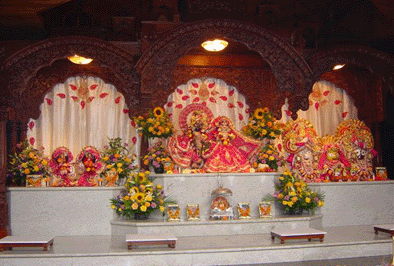

Sri Sri Gaura Nitai, Sri Sri Radha Giridhari, Sri Sri
Jagannath Baladev Srimati Subhadra Devi Mandir
..........you have to come to the temple to really appreciate Their
beauty and splendor.
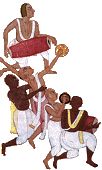 Auckland
Temple Daily Programme:
Auckland
Temple Daily Programme: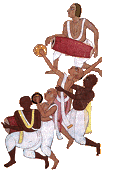
4:30 am Mangal Aratik
5:00 am Tulasi Aratik
7:00 am Greeting Their Lordships - Darshan Aratik
7:10 am Srimad Bhagavatam class
7:50 am Dhupa-Aratik
8:00 am Gurupuja for Srila Prabhupada
8:30 am Prasadam
12:30 pm RajaBhoga Aratik ( curtains close at 1:00pm -
4:00pm )
4:00 pm Dhupa Aratik
7:00 pm Sandhya Aratik ( Gaura Aratik )
9:00 pm Sayan Aratik
9:10 pm Temple Closes.
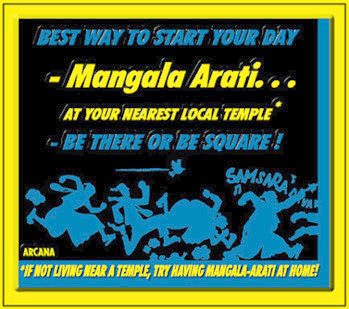


Phone (09) 412-8075
(09) 412 7642
E-mail: 

Every Sunday
Come to New Varshan's Famous
Hare Krishna Sunday
Feast
Music, philosophy, and a vegetarian banquet
Auckland: 12:30 pm Come Hungry and Bring
a Friend !
Phone (09) 412-8075
(09) 412 7642
E-mail: 



Auckland Nama Hatta Devotees
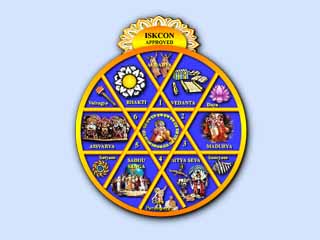
Click HERE for
Auckland Naam Hatta
ENQUIRIES PLEASE CALL:
Rasa-Parayana das (Ramaiya Naidu):
(09) 279 5530
Rasa behari devi dasi: (09) 412 8075


Hare Krishna School
State Integrated "Special Character" Primary School
Phone (09) 412 6325
Hare Krishna Playgroup
Just before the end of Term Four 2002 the Hare Krishna
Playgroup started in the house of Hina and Pankaj Gandhi, 862 Dominion
Road, Mt Roskill.
The Playgroup is now closed for the Summer break and
will open at the end of January.
For further information contact – mailto:pankajdiamond@hotmail.com
I hope this meets you well,
Yours in the service of Krishna,
Krsnendu dasa
Hare Krishna School
Thinking of enrolling in the Hare Krishna School or Hare
Krishna Playgroup?
Want to find out about… curriculum? school bus? school
fees? future plans for the school?
Come and have your questions answered!
Hare Krishna School is a state-integrated primary school
that covers all subjects in the New Zealand Curriculum plus Sanskrit, Vedic
culture and values in a rural setting.
Bus transport is available every day from central suburbs
(Sandringham, Mt Roskill etc.)
Hare Krishna Playgroup provides early childhood education
for children aged 3-5 years at two locations:
Riverhead—Krishna conscious education for preschoolers
in a rural setting.
Mt Roskill—Krishna conscious preschool education in English
and Hindi
I hope this meets you well,
Yours in the service of Krishna,
Krsnendu dasa
Hare Krishna School
* The Hare Krishna School is a 9am - 3pm 5 days-a-week
government funded school that covers all core subjects in the New Zealand
Curriculum and in addition teaches Sanskrit, Sastra and Vedic arts. Children
who come to this school get everything that children at state schools get
plus Vedic culture and values.
Hare Krishna School
Emailto:HKSchool@xtra.co.nz
Ph: 09-412-6325
Mob: 021-265-7587
Fax: 09-412-6325
Find out what the Education Review Office thinks of the
Hare Krishna School. Click the link below.
http://www.ero.govt.nz/publish/reppub.ns4/Institution/98CA326F2C53BF0CCC256B7500174198/$File/4204.htm?OpenElement
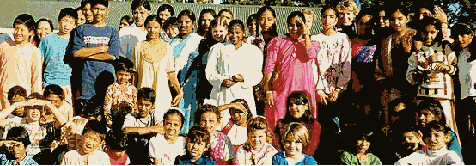
Bhaktivedanta Gurukula at
New Varshan (Summer Camp)
See the Youth pages


Ideas for helping at the
New Temple:
* There's so much to do still........
* Don’t miss out! Many opportunities for devotional service
are available.
* Can you offer practical assistance - skills?
* Would you like to be a Sponsor for Deity offerings made
daily
* Would you like to be a Sponsor for Sunday feasts
* Any contributions towards the temple, e.g., road improvements,
landscaping etc. will be most appreciated.
Please contact: Jaya Sila Das (412 8063) or Madri
devi dasi (412 8685) or Rasaparayana
dasa



 Are you Receiving
the HKNet Newsletter
Are you Receiving
the HKNet Newsletter
...are you receiving the Hare Krishna Newsletter from
Auckland?
If not send a message to Mother Madri to add yourself
to their list:
mailto:madri@pamho.net
mailto:harekrishnanews_auck-owner@yahoogroups.com
See the Kiwi yatra HERE:
http://www.hknet.org.nz/NZKiwi-yatra.html
Australian yatra here:
http://www.hknet.org.nz/aussie-yatra.htm

Hare Krishna Hare Krishna Krishna Krishna
Hare Hare
Hare Rama Hare Rama Rama Rama Hare Hare


Sacred Marriage - Vivaha
- Vedik Weddings

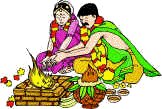

Marriage Compatibility Checking - Synastry
For marriage compatibility analysis bookings
http://www.hknet.org.nz/3-synastry.html
For more information about the system of analysis - the Vedik Kuta
system
http://www.hknet.org.nz/synastry9page.htm
For more information about Vedik Marriage Compatibility
http://www.hknet.org.nz/MarriageSynastry4U.html
Marriage Ceremonies
Vaag Daanam - engagement - betrothal
Haridra Lepanam - anointing
Milni - greeting the families
Kanya Sampradanam - giving the bride
Prati Sara Bandhanam - Tying red and yellow sacred threads on wrists
Swayamvarya - exchange garlands
Sindhur Daanam - marking bride's forhead with kumkum
Mangal Sutra Dharanam - tying the tali
Laja Homan - offering oblations
Mangala Phera - circumambulation of fire
Saptapadi Gaman - seven sacred steps
Murdha Abhishekanam - Sprinkling the couple with water to bind their
bond by sumangalis
Pani Grahanam - joining hands in wedlock
Sri Prasada bhojanam - couple feed each other
Shanti Daanam - onvoking peace
Prayaschitta homan - allaying resolve to purva-acharyas
Purnahuti - final oblation
Vamadevganam - prayers
Tilak dharanam - holding tika prasad on heads
Agniparinayana Pradakshinam - walking around sacred fire together
Catering available
performed by Iskcon brahmin priests according to ancient tradition,
and civil legal marriage according to New Zealand law.
For more details contact us:



The Temple, Temple Rituals, the Lord’s
Service and Us
(the full version that the edited Souvenir magazine version was taken)
Sri Gurubhyo namah, sarva lok Sri Hari bhakta namo namah
Hare Krishna, and welcome to the opening of the new temple.
In short I’ve been asked to run through an overview of what we are doing
here so that it will help our mutual appreciation of the event and make
it a positively memorial and enlivening step in all our lives.
The benefit to mankind for erecting a Vishnu temple:
In relation to the building a temple, in Sanskrit language to Devaalaya
consisting of two words namely Deva (God’s) and Alaya (House), or Deva
sthanams (place), the place where God resides.
The Lord’s priest, and deva (demigod) in charge of fire, Agni said (Agni-purana,'
XXXVIII, 1-50): I will now describe the fruits of making temples for the
residence of Vasudeva and other Deities. He who attempts to erect temples
for the Lord is freed from the sins of a thousand births. Those who think
of building a temple in their minds are freed from the sins of a hundred
births. Those who approve of a man's building a temple for Krishna go to
the region of Achyuta [Vishnu] freed from sins. Having desired to build
a temple for Hari, a man immediately takes a million of his generations,
past and future, to the region of Vishnu. The departed manes (for-fathers)
of the person who builds a temple for Krishna live in the region of Vishnu,
well adorned and freed from the sufferings of hell. The construction of
a temple for a Deity dissipates even the sin of Brahmanicide. By building
a temple one reaps the fruit, which he does not even gain by celebrating
an arduous sacrifice. By building a temple one acquires the fruits of bathing
at all the sacred shrines or Tirthas. The construction of a temple, which
brings forth all good results, by a religious or an irreligious man, yields
the fruit reaped by persons slain in a battle undertaken on behalf of the
celestials. By making one temple one goes to the heavenly planets and remains
there a long time; by making three one goes to the region of Brahma; by
making five one goes to the region of Shambhu (Siva); by making eight one
goes to the region of Hari. By making sixteen one attains all objects of
enjoyment and emancipation. A poor man, by building the smallest temple,
reaps the same benefit, which a rich man does by building the biggest temple
for Vishnu. Having acquired wealth and built a temple with a small portion
of it, a person acquires piety and gains favours from Hari. By making a
temple with a lakh of rupees (Rs 100,000.), or a thousand, or a hundred,
or fifty, a man goes where the Garuda-emblemed Deity resides. He, who in
his childhood even playing as children do makes a temple of Vasudeva with
sand, goes to His region. He, who builds temples of Vishnu at sacred places,
shrines, and hermitages, reaps three-fold fruits. Those who decorate the
temple of Vishnu with scents, flowers, and sacred mud, go to the city of
the Lord. Having erected a temple for Hari - Krishna, a man, either fallen,
about to fall, or half-fallen, reaps twofold fruits. He who brings about
the fall of a man is the protector of one fallen. By making a temple for
Vishnu one attains to his region. As long as the collection of bricks of
Hari's temple exists, the founder of his family lives gloriously in the
region of Vishnu. He becomes pious and adorable both in this world and
in the next.
He who builds a temple for Krishna, the son of Vasudeva, is born as
a man of good deeds and his family is purified. He, who builds temples
for Vishnu, Rudra, the sun-god, and other deities, acquires fame. What
is the use to him of wealth, which is hoarded by ignorant men? Useless
is the acquisition of riches to one who does not have a temple built with
hard earned money for Krishna, or whose wealth is not enjoyed by the Pitris,
Brahmanas, celestials, and friends. As death is certain for all men, so
is his destruction. The man who does not spend his money for the Lord’s
enjoyment or in charities and keeps it hoarded is stupid and is fettered
even when alive. What is the merit of him who, obtaining riches either
by an accident or endeavour, does not spend it for a glorious work or for
religion? [What is the merit of him] who, having given away his wealth
to the leading twice-born, makes his gift circulated, or speaks of more
than he gives away in charities? Therefore, a wise man should have temples
built for Vishnu and other deities. Having entered the region of Hari,
he acquires reverential faith in Narottama [Vishnu – the well wisher of
all mankind]. He pervades all the three worlds containing the moveable
and the immoveable, the past, future, and present, gross, subtle, and all
inferior objects. From the secondary creator Brahma to a pillar everything
has originated from Vishnu. Having obtained entrance into the region of
the Great Soul, Vishnu, the omnipresent God of the godly, a man is not
born again on earth.
In the sacrifice attendant upon the setting up of an Archa-vigraha
(Deity) there is no end of fruits that naturally come. One made of wood
gives greater merit than one made of clay; one made of bricks yields more
than a wooden one. One made of stone yields more than one made of bricks.
Deities made of gold and other metals yield the greatest religious merit.
Sins accumulated in seven births are dissipated even at the very commencement.
One building a temple goes to heaven; he never goes to hell. Having saved
one hundred of his family, he takes them to the region of Vishnu. Yamaraj
the administrator over the court at death said to his emissaries: 'Do not
bring to hell persons who have built temples and adored Deities. Bring
those to my view who have not contributed to build temples. Range thus
rightly and follow my commands.
Yamaraj to his Yamadutta assistants, 'Persons can never disregard your
commands, except those who are under the protection of the endless father
of the universe – Sri Vishnu. You should always pass over those persons
who have their minds fixed on the Lord. They are not to live here in the
Plutonic kingdom. You should avoid from a distance those who adore Vishnu.
Those who sing the glories of Govinda and those who worship Janardana [Vishnu
or Krishna] with daily and occasional rites should be avoided and left
alone by you from a distance. Those who attain to that station should not
even be looked at by you. The persons who adore Him with flowers, incense,
foodstuffs and wonderful ornaments should not be marked by you. They go
to the region of Krishna. Those who smear the body [of Vishnu] with unguents,
who sprinkle His body, or who bathe His body, should be left in the abode
of Krishna. Even a son or any other member born in the family of one who
has built a temple of Vishnu should not be touched by you. Hundreds of
persons who have built temples of Vishnu with wood or stone should not
be looked at by you with an evil mind as for others.'
He who has built a temple for Vishnu reaps the great fruit which one
gains by celebrating sacrifices every day. By building a temple for the
Lord he takes his family, a hundred generations past and a hundred to come,
to the divine region of Achyuta (the infallible one). Vishnu is identical
with the seven worlds. He who builds a temple for Him saves the endless
worlds and himself attains his rightful place in immortality. As long as
the bricks will last, the maker [of the temple] will live for so many thousands
of years in the heavenly planets if he so desires. The maker of the Deity
attains the region of Vishnu and he who consecrates the installation of
the same is immersed in Hari. The person who builds a temple and an image,
as well as he who consecrates them, come before him in due course of time
as a lost son is welcomed back to the father’s abode.
The rite of pratishtha (installation) of Hari was related by Yamaraj.
For creating temples and images of the Deities, Hayashirsha in his Pancharatra
supplement described it transcendentally to Brahma.
Use of ritual symbology, and it’s functionality:
The scriptures such as Pancharatra, Hari Bhakti Vilas, Apasthambha
sutras, etc are sometimes referred to as Vaishnava tantra. Today the word
tantra is much misunderstood, actually it refers to ritual acts. Deity
worship is full of ritual acts; offering incense, lamps, flowers and so
on. In the course of our presentation here we will be using aspects of
ritual symbology to further enhance our understanding. How it works
is that Vaishnava symbology is empowered with subtle communicative images
that externally our bodily experiences and emotions often do not pick up
on. Yet they deeply affect us, and remind us over a long period of time
of what we are doing, so I’ll do my best to explain that here.
Vedik culture to my understanding can be explained as follows, as being
dynamic and living experience that allows those who partake of it an entrance
into a new realm of awareness, communion and union with God.
Veda means knowledge, and culture refers to the process by which one
can cultivate that understanding. Lord Sri Krishna in Bhagavad Gita 15:15.,
tells us:
sarvasya chäham hridi sannivishtho
mattah smritir jnänam apohanam cha
vedaish cha sarvair aham eva vedyo
vedänta-krid veda-vid eva chäham
Let us look at the second part of this verse first “By all the Vedas,
I am to be known. Indeed, I am the compiler of Vedänta, and I am the
knower of the Vedas.” And in the first part He says “I am seated in everyone’s
heart, and from Me come remembrance, knowledge and forgetfulness.”
So it is a living dynamic, not something imagined or concocted, rather
Lord Sri Krishna has given methods by which we can come to Him (B.G. 10:10.),
by which we can, at all stages of our conditioned maturational development
in this life be again redirected toward Him, in our rightful constitutional
position as His eternal servants. In this way Vedik culture is alive, and
practical and gives direct perception of God through all of our daily actions
and remembrances. It is very simple to do:
yat karoshi yad ashnäsi
yaj juhoshi dadäsi yat
yat tapasyasi kaunteya
tat kurushva mad-arpanam
“Whatever you do, whatever you eat, whatever you offer or give away,
and whatever austerities you perform — do that, O son of Kunti, as an offering
to Me.” (Bhagavad Gita 9:27.)
sriyah patir yajna-patih prajä-patir
dhiyäm patir loka-patir dharä-patih
patir gatish chändhaka-vrishni-sätvatäm
prasidatäm me bhagavän satäm patih
“May Lord Sri Krishna, who is the worshippable Lord of all devotees,
the protector and glory of all the kings like Andhaka and Vrishni of the
Yadu dynasty, the husband of all goddesses of fortune, the director of
all sacrifices and therefore the leader of all living entities, the controller
of all intelligence, the proprietor of all planets, spiritual and material,
and the supreme incarnation on the earth (the supreme all in all), be merciful
upon me.” (Srimad Bhagavatam 2:4:20.)
Everything here in this world has, whether we recognize it or not, been
manifested by God, and similarly, as mentioned here in this verse He is
known as Pati, or Lord, or provider, and as any provider, He is pleased
when there’s personal interaction showing gratitude by those He provided
for.
Many of us are householders, having families and children, dependents
who out of love we look after. That love is further magnified when it becomes
reciprocal, just like I may feel some pleasure in giving my son or daughter,
or wife, some sweets, but when they offer it back to me, then immediately
my love for them is realized in a practical way “oh just see, such a nice……boy/girl….”
So what we are doing here, in using everything at our disposal in the service
of the Lord is done in the same way, being personal reciprocal acts of
loving devotional service, it invokes direct appreciation and love for
God – Krishna.
A man asked me once, “…show me God, I want to see God !” In seeing God,
it takes some adjustment in our present consciousness. At present, we are
here in this world thinking that it is our place to enjoy without recognition
of the ontological proprietorship of the Lord. As we mentioned He is the
provider for all beings, He is the original Person, the energetic that
has structured the energy, i.e. He was there before any re-structural or
elemental “big bang” of this material world, there before the engineers
and technicians began to manipulate the gross elements to create.
Just as we see in a working situation, it is important that one
understand who is the boss (the pati) paying the wages is, and who is the
worker who follows the guidance or directive of that company is. If both
are recognized, free from envy of the other’s position a sense of mutual
appreciation is gained. If I, the worker refuse to recognize the boss,
worse still if I try to usurp some of the boss’s property as my own I will
find myself in trouble and subject to restrictive disciplinary action,
itself proof of the boss’s proprietorship. Better, and more pro-active
would be if I humbly recognized his proprietorship and show recognition
to him.
In that way we can tangibly see the hand of God in everything, and
to such a faithful and loyal servant of the “boss” it is only a matter
of time until he/she too is recognized by the boss. This positive process
of recognition leaves a much better flavour in the pallet than the rebellious
criminal mentality of envious denial of the Lord’s proprietorship.
In this same way, if we recognize from where everything is coming,
and if we use properly, as they are intended, those elements of this world
as intended by the proprietor, Krishna, the company, His company, in helping
us to see Him everywhere is a success.
Over the ages different persons have recognized the wonders of His nature;
“Even the savage and uncivilized men in the jungle who are not trained
up in the artificial conventions of civilized nations bow down to the order
of the Supreme Powerful. As such they worship the emblems of theism in
the form of thunderbolt, big ocean, big mountain, and gigantic natural
phenomenon. The dormant obedience for the Supreme is artificially stumbled
by the convention of so-called civilized men.”(Srila A.C. Bhaktivedanta
Swami Prabhupada. Copied from hand written document for old BTG in SP rooms
in Vrindavan. Page 4. excerpt)
Just as Moses saw the Lord in the form of a burning bush, or Mohammed
heard the Lord in the form of sound, or for His devotee Prahlad the Lord
manifested Himself from a pillar to kill the opponent to these His cognizant
teachings etc., then if we are truly “God conscious” please then show me
a place where He cannot be or reside. It’s not that we have to artificially
contort the mind to see something that is not there, or strain our intelligence
to capture some esoteric thing available to but an exclusive few. Given
that we are at least willing to be shown, that is that we are at least
open minded to the possibility that someone can show me something that
I have yet to realize, there is hope. After all, we are asking, “Show me
God”, it means we don’t know, we haven’t seen, but we want that audience.
We are in need of approaching someone who has seen, who has access, otherwise
we cannot approach.
We were talking of the boss, then what to speak of the King, “Show me
the King !” We may demand like this, but the king’s position is that He
doesn’t have to come at our every calling. If one at all wants to see the
king, there’s a process, protocol and etiquette that must be followed.
By acting in such a way that the king will readily accept seeing us changes
the paradigm dramatically, for when the king wants to see us, then who
can stop him. One who knows the king, and is close to the king, such as
a secretary, they can make the introduction and audience is easily gained.
We need to be qualified to have that audience, no one in an undisciplined,
rebellious state is invited into, or attains that association. However,
anyone having been trained to observe non-envious dealings as mentioned
in Bhagavad Gita’s 12th chapter (verses 8-12.). Those who have unconditioned
love for Him, who are without material misconceptions, and who are spontaneously
attracted to Him so much ritual is unnecessary.
The balance is given for us, in that our rituals be focused on simply
pleasing Krishna, in that way, simple, and with focused objectivity the
directives of the scriptures give insights that in this age reliance solely
on ritual will not be fruitful. In this age where there are so many short
comings, all of the requirements for elaborate Deity worship are simply
not available as they were previously, and nor are the priests. Priests
that are pure by thought, action and character, materially detached in
nature, being fixed in devotion, have clear memories to recite perfectly
mantras with exact swara-suddhi pronunciation, timing, and structure, are
also not so readily available. Therefore following the yuga-dharma of congregational
chanting of the Lord’s holy name (sankirtana) as taught by Sri Chaitanya
Mahaprabhu, and His followers the Goswamis of Vrindavana, and incorporating
the practical Vaishnava tantra of their teachings such as Hari Bhakti Vilas,
Dik Darshini Tika, and Narad Pancharatra, as well as Srimad Bhagavatam
serve to maintain the complete package.
“Especially in this age of Kali, sankirtana alone is sufficient. If
the members of our temples in the different parts of the world simply continue
sankirtana before the Deity, especially before Sri Chaitanya Mahäprabhu,
they will remain perfect. There is no need of any other performances. Nevertheless,
to keep oneself clean in habits and mind, Deity worship and other regulative
principles are required. Srila Jiva Gosvämi says that although sankirtana
is sufficient for the perfection of life, the archanä, or worship
of the Deity in the temple, must continue in order that the devotees may
stay clean and pure. Srila Bhaktisiddhänta Sarasvati Thäkura
therefore recommended that one follow both processes simultaneously. We
strictly follow his principle of performing Deity worship and sankirtana
along parallel lines. This we should continue.” (Srila A.C. Bhaktivedanta
Swami Prabhupada. Srimad Bhagavatam 6:3:25. purport)
Thus the process and protocols that we are following under the guidance
of the expert spiritual master are set, and following the direct instructions
given in the revealed scriptures where the Supreme Lord Sri Krishna gives
personal instruction to His dear friend and follower Uddhava (Srimad Bhagavatam
11:27th chapter) as to how engage in kriyä-yoga, or Deity worship.
“….the bhakti-yogi accepts the Deity of Krishna as worshippable because
there is some bodily conception fixed in the mind, which can thus be applied.
Of course, worship of the Supreme Personality of Godhead in His form within
the temple is not idol worship. There is evidence in the Vedic literature
that worship may be saguna and nirguna—of the Supreme possessing or not
possessing attributes. Worship of the Deity in the temple is saguna worship,
for the Lord is represented by material qualities. But the form of the
Lord, though represented by material qualities such as stone, wood or oil
paint, is not actually material. That is the absolute nature of the Supreme
Lord.
A crude example may be given here. We may find some mailboxes on the
street, and if we post our letters in those boxes, they will naturally
go to their destination without difficulty. But any old box, or an imitation
which we may find somewhere but which is not authorized by the post office,
will not do the work. Similarly, God has an authorized representation in
the Deity form, which is called archä-vigraha. This archä-vigraha
is an incarnation of the Supreme Lord. God will accept service through
that form. The Lord is omnipotent, all-powerful; therefore, by His incarnation
as archä-vigraha He can accept the services of the devotee, just to
make it convenient for the man in conditioned life.” (A.C. Bhaktivedanta
Swami Prabhupada. Bhagavad Gita 12:5., purport.)
Worshipping the Deity form of the Supreme Lord through the approved
process automatically brings purity and satisfaction to the mind. Thus
it is the source of all desirable gains. If a person has no engagement
in Deity service he will simply remain attracted to material sense gratification,
based on their own personal likes and dislikes, and he will have no hope
of reforming one’s life, giving up bad association, and entangling material
mannerisms. (Srimad Bhagavatam 11:27th chapter)
The Personality of Godhead has given instruction, among the regulations
of the Sätvata scriptures (i.e.. Pancharatra and Agama tantra), on
the process of worshipping Him as the bona fide Deity. Not only He, but
Brahmä, Siva, Närada, Vyäsa and all other self realized
sages have recommended this process described by the Lord as most perfectly
beneficial for all the occupational classes and spiritual orders, and genders
of human society, without exception.
The system we follow is practically explained as follows as panch-anga
seva, being made of five departments that to the untrained eye may not
be appreciated in the ceremonies done for this opening, and in the on-going
Deity worship performed for the Lord’s pleasure here:
1. Abhigamana (approaching the temple): This includes the basic
preparatory activities such as cleaning oneself physically by bath, the
wearing of appropriate and fresh cloth, marking the body with the symbols
of Vishnu tilaka and wearing sacred Tulasi beads (kanti mala) around one’s
neck, cleaning the temple proper, and removing used articles and cleaning
them, and decorating the temple for the Lord’s pleasure, 2. Upadana (gathering
articles - dravya): This includes gathering fragrant flowers, Tulasi
leaves and manjaris (buds), suitable seasonal fruits, preparing first class
cooked foods, and selecting the proper utensils for the various aspects
of the functional worship, 3. Yoga (attaining spiritual identity): This
includes cleansing the body of material conception and assuming a spiritual
body fit for service to the Lord, by means of mantra, bhuta suddhi (introspective
constructive analysis of who we are as eternal servants of Krishna, where
we have been in life wandering in cycles of repeated birth and death in
the material existence, then coming across sad-guru by great fortune and
becoming trained by him to understand our fortunate station as a devotee,
being allowed to serve the Lord in this personal way, and following in
the footsteps of such a mentor by practically doing so), dhyana (meditation
on the personal attributes and pastimes of the Lord, Who we are aspiring
to serve) and manasa puja (contemplating the subtleties of rendering such
service within one’s mind as a personal intense offering), 4. Ijya (worship):
This refers to the formal external worship proper, or offering of upacharas
(items) such as asana (a comfortable seat), padyam (soothing footbath),
tailam (pleasing oil massage), snana (full bath), vaastram (offering a
fresh change of cloth), dhupam (offering pleasing fragrant incense), dipam
(offering different kinds of illuminating lamps), naivedyam (offering palatable
foodstuffs), tambulam (after meal mouth fresheners) etc. 5. Svadhyaya (recitation
of scripture): This includes all of the processes of spreading the glories
of the Lord through various means of cultivation, such as reading scripture,
hearing and chanting the names and glories of the Lord, putting on festivals
in observance of events related to the Lord, like Janmastami (Sri Krishna’s
birthday), Radharani’s birthday, Lord Chaitanya’s birthday, or Snan yatra
or Rathyatra etc.
This systematic process is sometimes also identified by its purificatory
aspects: Sat suddhi (six kinds of purities that are achieved); 1. Sthana
suddhi (purity of the place) means the gross and subtle purification of
a place by washing, and decorating with auspicious elements that have been
ritually purified with mantra; 2. Dravya suddhi (purity of the articles
used) articles that according to shastra are offerable. Such articles are
then spiritualized with mantra and mudra; 3. Atma suddhi (purity of body)
as contamination spreads by touch, the devotee must be careful to avoid
touching impure items such as the holes of the body, hair, the lower part
of the body, the cloth covering the lower body, feet, floor, or any impure
item (stool, urine, blood, fat, marrow, bone, tears, ear wax, phlegm etc).
Offered articles are also considered impure (prasadi) for one who is going
to offer fresh articles. Therefore the devotee is careful to avoid touching
offered items. Before touching an unoffered item he should wash his hands.
The water used to wash hands should not be thrown in such a way to contaminate
other objects. The left hand, considered impure, should not touch the Deity;
4. Chitta Suddhi (purity of mind) the mind should have been purified through
the samskara of Vaisnava initiation, by which he has received Vaisnava
mantras for worshiping the Lord, and by his daily Vaishnava sadhana or
sad-achara, keeping positive devotee association; 5. Mantra suddhi (purity
of mantra) mantra given by guru with which one worships the deity is important
in Pancharatrik puja, for sound is the most powerful method of associating
with the Lord; 6. Murti Suddhi (purity of the Deity) basic physical purification
of place, articles and body, before the puja proper; subtle purification
of these elements and spiritualization of body and mind as the first step
in worship (purvanga karmani); preliminary worship, such as guru puja;
worship of the murti in the mind (manasa seva); worship using the external
articles (bahya pujan); concluding activities to enforce the idea of full
surrender to the Deity; activities of the day which are favorable for the
development of loving devotion to the Lord, i.e. all types of devotional
service:
These may seem like common sense things and they are, but for most
of us due to our forgetful state being covered by the modes of nature in
this world need to be reminded, and have explained to us what we are doing
and how fortunate we are to be allowed to participate in any way in this
service. However, those whose minds are fixed in the deep understanding
of who we are and Who Krishna is, and the available reciprocal relationship
between the two, there’s little need of ritual, purvanga karmani purification
systems or classes, as it is already realized.
Srila Baladev Vidya Bhushana, a great devotee in our line of spiritual
teachers, mentions that for some who are somewhat materialistic there are
side effects or fruitive results that they may aim for while performing
acts of service, yet for those who render service out of love instead of
for gain receive spiritual results:
"As for the various fruitive results, such as the attainment of rain,
a son, or residing in a celestial material planet, that are offered to
the followers of the karma-kanda rituals in the Vedas. These benefits are
offered to attract the minds of ordinary men. When ordinary men see that
these material benefits are actually attained by performing Vedic rituals,
they become attracted to study the Vedas. By studying the Vedas they become
able to discriminate between what is temporary and what is eternal. In
this way they gradually become averse to the temporary things of this world
and they come to hanker after Brahman. In this way it may be understood
that all the parts of the Vedas describe the Supreme Personality of Godhead.
Vedic rituals bring material benefits as a result only when the
performer of the ritual is filled with material desire. If the performer
is materially desireless, then he does not gain a material result, but
rather the result he obtains is purification of the heart and the manifestation
of spiritual knowledge. Therefore the meaning of the verse 'tam etam vedanuvacanena
brahman vividisanti', 'brahmanas study the Veda to understand the Supreme
Personality of Godhead' (Brhad Aranyaka Upanishad 4:4:22.) is that in the
Vedic rituals when one is required to worship a particular deva, one does
so as a limb or representative of the Supreme Personality of Godhead, and
thus by worshipping them one is actually worshiping the Supreme Lord, the
result being that one gradually becomes pure in heart and awake with spiritual
knowledge."(Baladev Vidyabhushana. Govinda Bhasya commentary on Vedanta
Sutra 1:4:4. Adhkarana sutra 4.)
This is practically experienced when one builds an elaborate temple
for the Deity of the Lord to reside in, the perfect arrangement in the
perfect setting, for the perfect Person. Some however see the Deity as
being made of stone, a most unfortunate and depriving thing for them. We
are reminded again and again that the Deity should never be seen as mere
stone, rather if we are to appreciate God’s omnipotent position we must
be careful to see Him standing before us in an easily manageable form that
we can relate to and practically through daily offering loving service
interact with. To those who worship Me with love I give the understanding
by which they can come to Me (Bhagavad Gita 10:10.)
As the Lord is living, so the Vaishnava temple is also considered to
be “alive”, and as such a suitable body in which the Deity may reside.
Just as you or I are the living being who resides within this body, and
who permeates it with consciousness, so similarly the gross outer covering
of the temple building should resemble the form of a person as depicted
in the illustration from south India below.
It is no meager choice of words to say that the body of devotees also
represents the Lord in His various functionary aspects according to varna
and ashram (one’s work and social status), thus it is called Daivi-varnashram
or the social system dedicated to the Lord. We make ourselves available
to greet and engage those who the Lord sends, and assist them as we too
have been engaged to serve the Lord according to His plan. So often we
have experienced that when a particular thing needs doing, suddenly out
of the blue a willing person or resource becomes available, how is that,
if not by the Lord’s design. There is much more to erecting a temple than
mere bricks and mortar, there are many subtleties evolving being germinated
by the mercy of the Lord on the jiva souls in the region.
The temple proper as depicted above is like our body made of various
limbs; the Kalash dome is situated upon the top of the Vimana or Shikhara
which is symbolically considered to be the head of the temple, the inner
sanctum or griha garbha (Garbhagraha - Sanctum Sanctorum) where the Deity
resides is like the central nervous system and core of the neck, the kirtan
mandap or temple room as we call, where the Lord is glorified by loving
body of devotees, is considered the body area and in our case the holy
feet of the temple body are situated where the spiritual preceptor or Acharya
is seated.
In the course of the opening of the temple we will also formally recognize
the Lord’s perfect hierarchal plan of maintenance. He appoints a personality
called Vaastudeva or Vaastu Purusha to inhabit all buildings; he’s like
the caretaker. Theology affords us the to be conscious of everything in
the Lord’s universe, where it all fits in and how to properly use and honour
it. In all the old world cultures of what is now deemed the Pagan world
an awareness of all aspects of the universe and it’s cognizant role bridging
the realm from God to mankind was recognized. In New Zealand we see it
with local Maori, showing respect to the Earth mother, to the deity of
the sea or sky, in rain, or the Sun providing for our every need. It’s
the same simplicity and honesty founded in loving gratitude that is taught
in Isopanishad 4 - 6, it’s intrinsically natural to us.
The temple ceremonies:
Usually when constructing a temple one consults someone who knows the
science of Vedik Architecture and together with the Astrologer one finds
an auspicious day, and time that is steady in nature and free from blemishes
that may otherwise afflict a community. When the day is secured the purohit
(priest) would direct with consultation with the Sthapati (Vedik architect)
that upon the selected ground the first cut be at an auspicious time, the
ground is then ploughed from east to west by bullock with plough share
avoiding the killing of any living entity in the ground in the process,
as was done here.
When we perform the Admestika (the first cutting of the ground), Sila-ropana
(placing of the five foundation stones and Ananta Sesha – the Lord’s pith
seat), and other Deva-Griha-rambha rites which incorporate the worship
of Vastupurusha, he, as the humble servant of the Lord first says; no I
cannot accept this worship independently, first you worship Sri Vishnu
and His consort Griha-Laxmi (Dhana-laxmi), which is then done.
It marks the difference between the devotee and the none-devotee,
just as with all of us, some recognize the proprietorship of the Lord some
do not. There are millions of people who have bodily coverings like you
and me – we all eat, sleep, mate and defend, but not all honour the real
creator from whence all that this body is, has come. We as predominating
personality of this body among so many bugs, worms, germs, etc., living
within it recognize this fact, and pay homage. The same is there for the
universe, Lord Brahma and his associate Devas (demigods) who clear obstacles
in the way, and co-ordinate universal affairs under the sanction of the
Lord’s taratamya – hierarchal decree. Vastupurusha has his functionary
service to the Lord taking care of all that is built upon the Earth.
The fact of the matter is also there that even if one doesn't
honour the minister of the king, so to speak, he's still the representative
of the king and he's still there - and such neglect may be taken as an
act of offensive rebellion. Yet if one shows him due respect as a loyal
servant of the king, or in this case the Lord the Vastupurusha, as a nut
or screw properly fitted in the universal machine, he looks after the internal
and external affairs of the building and surrounding areas and assists
to create an ambience conducive to devotional service to The Supreme Lord.
Such a simple thing….
In the ceremonies that we will be conducting, rather than trying to
individually honour all 33 million of the Lord’s departmental heads, just
as one does when watering a tree that supports many leaves, we will be
aiming our main focus at the root – Sri Krishna, and in that way in unison
with His being satisfied all branches and limbs also are addressed.
Formal declarations of intent (sankalpam) will be enunciated by the
temple authorities (pratiprathastri) addressing the Deities, to declare
the commitment of the devotees, what the plans are, to beg forgiveness
for any inconveniences caused and to ask for the Lord’s mercy that we may
complete the task.
All kinds of practical tests are set to ceremony to please the Lord,
such as Mrd Harana where we gather soil and plant seeds on the site after
it has been cleared to see how the site will bear fruits of sacrifice.
Removal of Dristi (unwanted negative effects) is symbolically done by calling
it to one central place and disposing of it, being burned into fire into
the northeastern corner of the property.
Some of you may be familiar with other fire ceremonies where oblations
of ghee (clarified butter) are sacrificially offered with mantra into the
sthandila hearth where the element of fire stands to accept the offering.
This is sometimes called Yajna, Homan, Havan, and while the fire itself
is said to be the medium to carry the offerings of ghee, grains, flowers,
spices, milk, honey and fruits through the fire, which acts as the mouth
or consuming agent which carries the offering to Vishnu, through His priestly
ambassador Agni. It is said the wood is/are the ears of the fire; the smoke
is/are the nostrils; the meager flames are the eyes; the coals are His
head; the full flames are His tongue. Therefore shastra (scripture) highly
recommends that one should make offerings to the tongue of the fire.
That means one should offer oblations into a fully blazing fire.
om agnai ayahi voi toi ayaa
toiaya grinanho vyadatoiaya toiya
ni ho ha ta sa sai baa ho va hi shi
harih om
.
"Oh Agni, come to the banquet, after being extolled, come to
the gift of offerings, sit down invoker of Vishnu, take your seat on this
sthandila hearth." (Gramageyagana 'Ganapat' 1-1-3., Rk 6-16-10., samaved)
The offering is accompanied by Vedic mantras, which address the Lord
in a specific form and carry a specific request.
yajnärthät karmano ’nyatra
loko ’yam karma-bandhanah
tad-artham karma kaunteya
mukta-sangah samächara
"Activity or work(s) done as a sacrifice for Vishnu has to be performed,
otherwise work causes bondage in this material world. Therefore, O son
of Kunti, perform your prescribed duties for His satisfaction, and in that
way you will always remain free from bondage."(Bhagavad Gita 3:9.)
In the Sudarshan tatha homan, various mantras to invoke and appease
the Sudarshan discus weapon of the Lord will be recited and invoked into
the waters of the Kalash that will later be taken around on procession
to purify and protect the temple and Deities within, and also used to install
the main Kalashas, and the Sudarshan chakra symbol and Dhwaj (Pataka) flag
on the roof of the temple with abhiseka bathing and panch upachar seva
(offering five items).
You will also note that during the proceedings the honourific ceremonial
public bathing ritual or Abhishek is offered to the Deity upon arrival
at the new temple. The Deities will then be placed on Their altar amid
profuse glorification of sankirtan by Their loving devotees as a culmination
of so many years coming, after being bathed in the waters from the Sudarshan
homan.
As we understand from Bhagavad Gita that the eternal soul, in this
case the Lord (the Archa-vigraha), moves from one body to another at the
time when the former body is no longer functional for it’s use. In this
case, the new body, the temple decorated with blood sweat and tears is
ready for the Lord to inhabit. Seeing like this it is easy to understand
that the Deity as being the life and soul of the community is moving to
a new and more suitable body analogous of a rebirth, for a growing devotional
community.
Once the Deity is placed in Their final resting place, They are offered
many items of worship in great pomp adding to 64 items. Purusha sukta homan,
Vaishnava homan, Prayascitta homan fire ceremonies will all be performed
to invoke the blessings of the Deities upon the community, and to counter
any and all short-comings.
This is a very special ceremony, and later in the day some members
of the devotional congregation who have sponsored will themselves come
forward to honour the Deity in this way. For this the Lord’s Utsava bera
or Vijay vigraha – functional or festive representative will come forward
to allow access to the many devotees coming forward and those devotees
will bathe the Deities with 1008 kalashas. At that time, the newly placed
Deities will have taken some rest in the afternoon, to appear in Their
opulent new set of clothes for the evening program.
Over the next couple of days various cultural programs as mentioned
in the programme will go on, and on the Monday some devotees will take
diksha in front of the Deities in the new temple.
We trust that all will have a wonderful time and that with the Lord
firmly situated in Their new temple, that They inspire and enthuse all
of us to serve Them nicely in whatever capacity we can, and that by so
doing, the ripple effect infect more and more to do the same, and in so
doing all engage in glorifying Sri Sri Gaura Nitai, Sri Sri Radha Girdhari,
Sri Sryuts Jagannath Baladev Subhadra, through Their dear servant and Founder
Acharya of Iskcon, Srila A.C. Bhaktivedanta Swami Prabhupada.
I beg to remain humbly in the service of the Lord and His devotees.
Sri Krishnarpanamastu
Yours in service, Pt. Jaya Tirtha Charan dasa

Condolences
Devotees of Iskcon New Zealand would like to offer our
condolences to the family and friends of former New Zealand Prime Minister
Rt Hon David Lange who passed away recently (14th August 2005).
He was a good friend of the Hare Krishna devotees, dearly
loved prasadam, he was guest of honour at the ground breaking ceremony
of the new Auckland temple which was started in 1987.

He had a great affiliation with all cultures but especially
had a love for India which he visited several times, and considered himself
a follower of Mahatma Gandhi. He was well known and loved for his sharp
wit and an honest and out spoken politician.
Devotees went to see David Lange in his last days, and
Auckland's Hare Krishna school children sent their well wishes to him in
Middlemore hospital through many cards.
He had suffered throughout his life from ill-health, but
the last few years more so with diabetes and kidney problems, yet even
up to the last minute after having his leg removed he joked asking if they'd
got the right one. In fact he was still renowned for his jovial disposition,
booming voice and legendary irreverence.
More can be read about him here http://www.smh.com.au/articles/2005/08/14/1123353547721.html?from=rss&oneclick=true

ISKCON (International Society
for Krishna Consciousness)
Founder-Acarya, His Divine Grace A.C. Bhaktivedanta Swami
Prabhupada
RADHA GIRIDHARI TEMPLE, 1229 COATESVILLE-RIVERHEAD HIGHWAY
R.D.2 Kumeu, Auckland
Phone: +64-9-412 8075 Fax: +64-9-412 7130
PRESS RELEASE
HON. CHRIS CARTER, MINISTER FOR ETHNIC AFFAIRS, UNVEILS
“1 MILLION DOLLAR” PAINTING AT AUCKLAND HARE KRISHNA TEMPLE
CONTACT: Ketan Patel and Lakshmi Patel, Phone: +64 (09)849 7405 or
Mobile: +64 21 041 7164
E-mail: prudent@xtra.co.nz
DATE: July 24, 2006
The Auckland Hare Krishna Temple is approaching Krishna devotees and
well wishers in New Zealand and across the world in order to raise NZD
1 million within the next month to make the new Radha Giridhari Temple,
Auckland, mortgage - free.
The Hon. Chris Carter, Minister for Ethnic Affairs, visited the Hare
Krishna Temple on July 23, 2006 and unveiled a smaller version of the “1
million dollar Krishna painting” by renowned Ukrainian artist Dina Bandhu
Das. The painting will be auctioned during the “Janmashtami” celebrations,
Lord Krishna’s birthday on August 16, 2006. The same painting will be reproduced
on a wall measuring 4.17 metres x 2.82 metres in the temple’s main worship
hall. The temple is calling for sponsors to donate upto $1 million towards
this painting. (See www.iskconnz.com/1million for details.)
Mr. Carter was shown around the temple facilities by the temple’s council
members. He received blessings from the deities, Sri Sri Radha Giridhari
in the form of the ‘satari’ placed on his head and sipped ‘charanamrit’
(holy water).
After unveiling the painting, he distributed certificates to graduates
of the Bhakti-vriksha program, a course that involves serious study of
the Vedic scriptures.
A copy of the Bhagavat Gita As It Is and the abridged version of Srimad
Bhagavatam were given to the Minister as a memento of his visit.
Mr. Carter then partook of the opulent Sunday prasadam (feast) which
consisted of puris, pakoras, rice, dal, vegetables and cakes and sweets.
The Sunday mid-day feast is open to all visitors to the temple.
http://photography.techjunkie.co.nz/temple/index.html







 New
temple (now open pictured above)
New
temple (now open pictured above)













 Auckland
Temple Daily Programme:
Auckland
Temple Daily Programme:











